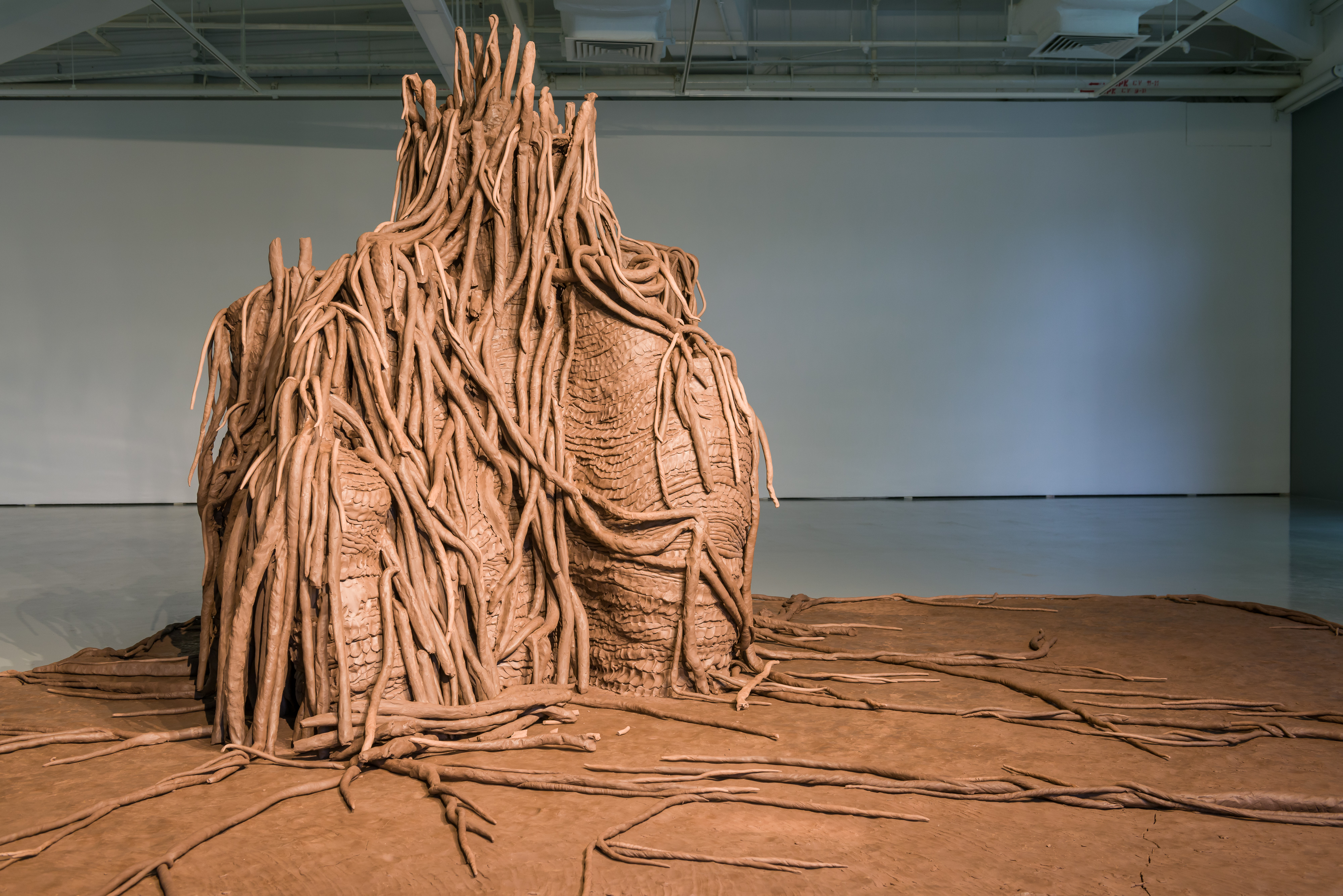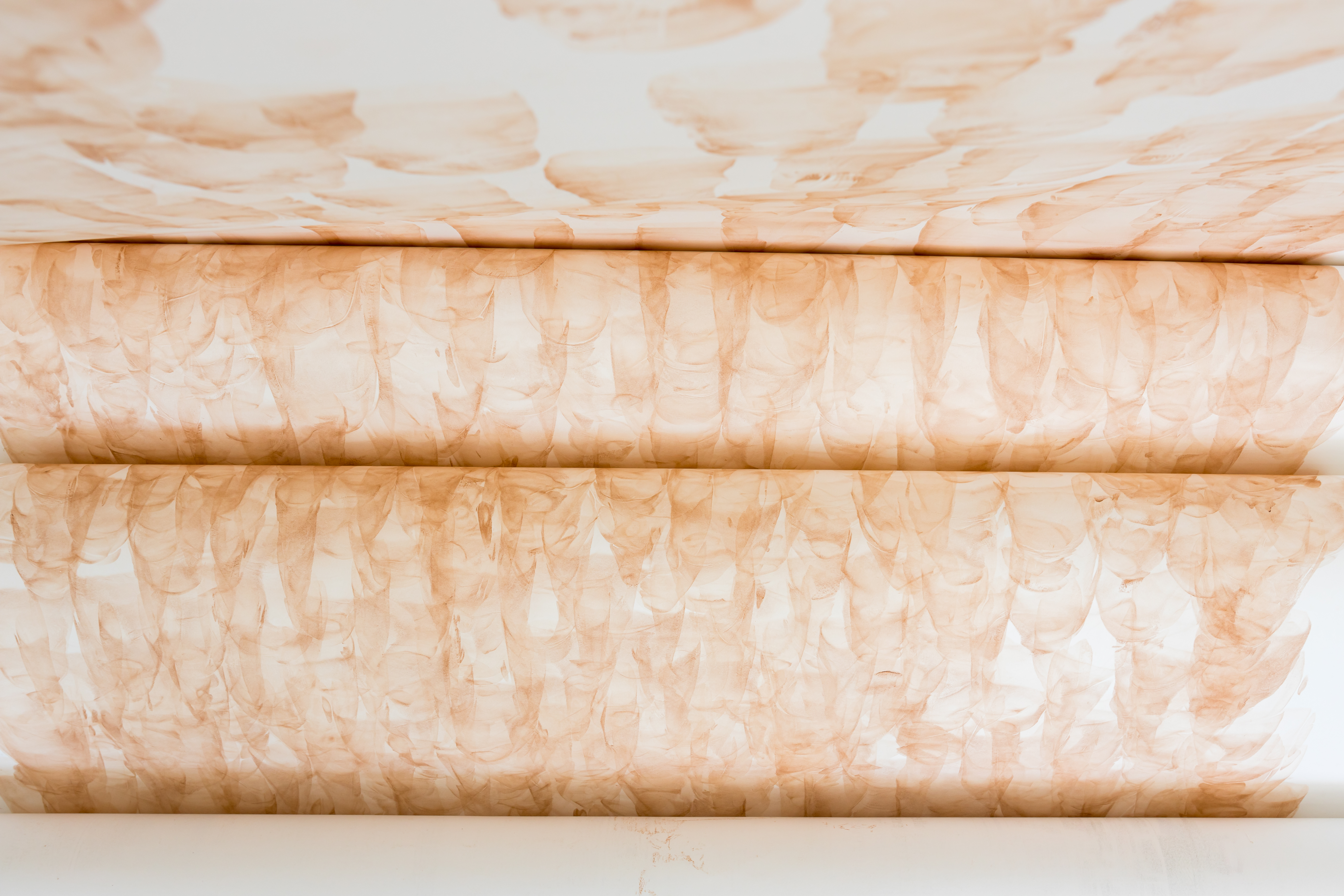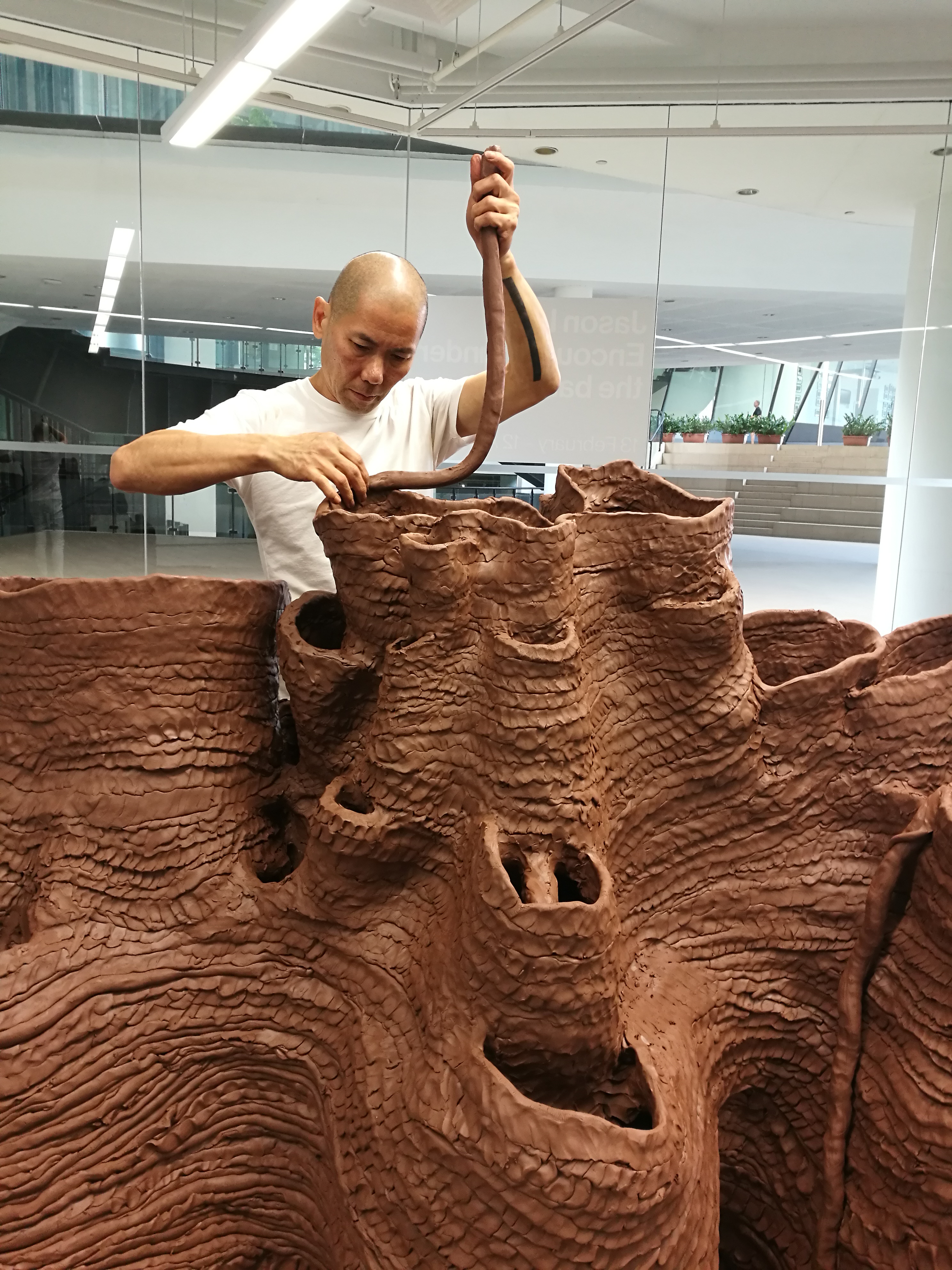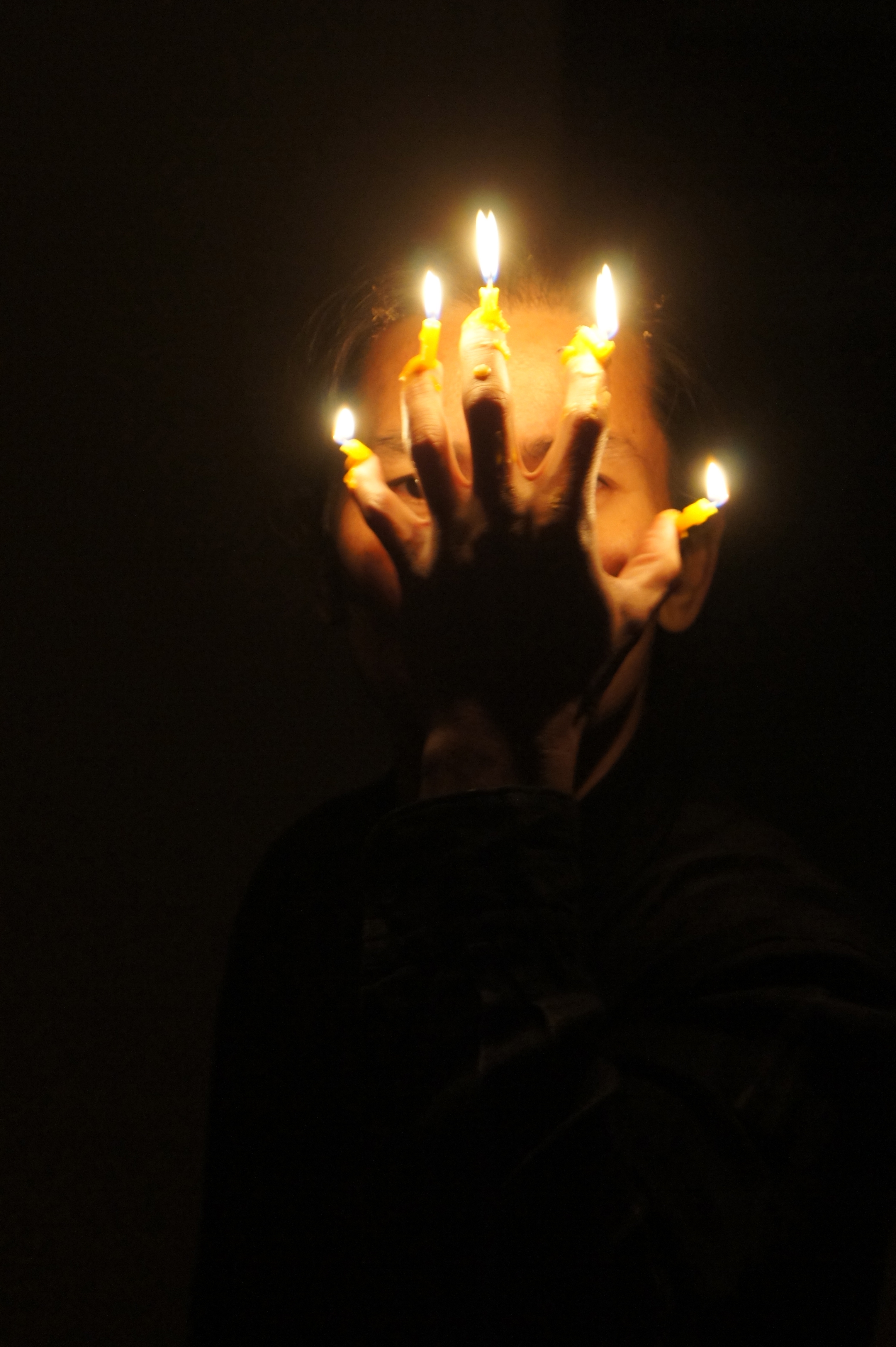Slow
Conversations
Issue: On Old-Growth
Issue: On Old-Growth
Jason Lim's repertoire of works encompasses ceramics, photography, installation art, and performance art. As a performance artist, he has been invited to present performances in more than 30 countries. As a ceramist, his works have been collected and commissioned by public museums, art institutions, and private collections, both locally and internationally. Future projects include Singapore Ceramics Now 2021 - Marking I Making, Singapore and Indian Ocean Craft Triennale 2021, Australia.

To kick things off, let’s begin by way of your selection of materials: fire, water, stone, earth, and wood. Tell us about your selection, which strikes me as being organic and elemental. What were some of the things you had in mind when putting together this selection?
I’ve been working with all of these materials in my performances, installations and ceramic practice, so this selection came to me quite naturally. I’m interested in these materials because they’re fundamental elements that we can find all around us — whether it is a tree or a branch, we can see all of these living materials in our surrounding environments. These materials are also directly related to alchemy, and in particular, Chinese alchemy (wuxing), where the five elements of wood, fire, metal, water, and earth play very important roles. In terms of numerology, the number five is also something that you see repeated in feng shui, astrology, or traditional Chinese medicine. To me, thinking about these materials by way of Chinese alchemy makes total sense. It accounts for how these five elements are connected: wood feeds the fire, ash from the fire produces earth, the earth bears metal, metal collects water, and water nourishes the wood. There is this sense of the elements feeding into one another. It makes sense for me to use these elemental materials because my works are not singular pieces. They are all interrelated. They might be different in terms of the sort of materials that are used, but through the ideas they explore, my works are all connected to each other. Having said that, it’s still important that the various series that I’ve worked on are still seen individually, be they performance or ceramic works.
Let’s spend some time discussing your deep relationship with and understanding of clay as well. Tell us about what drew you towards working with clay or as a ceramicist, and as someone who has worked with clay for awhile now, how has your relationship to the medium morphed or developed since?
My first encounter with clay was in secondary school. I went past an art class where the seniors were recycling used clay, and I saw this slushy, muddy pile of organic material slapped onto the table. I was quite curious as to what they were doing with all that mud, and that’s where it all began. My relationship to clay is very connected — my hands just respond to the organicity of the material. The more that I work or play with the material, the more I feel that the process is a direct transmission from what I’m thinking into what I’m making. It’s incredibly tactile, so the connection between what I’m thinking in my head, how I move my hands, and the form of the clay is very pronounced. Through the process of working with clay, I’ve also realised that I’m good with my hands and I prefer getting my hands dirty. It was the first material that I began making art with and spending time with, and I've held the material as something meditative as well.After my A Levels, I went overseas for ceramic training before coming back to Singapore in the early coming back from overseas with ceramic training. At that point, I didn’t have access to the appropriate equipment or a studio space, but I still wanted to continue making clay works. That was when I began making clay works without firing them. Doing that for the first two years was important for me because it helped me to realise that my art is interested in working with the material itself, and not so much about having a finished work that has been fired. I think of myself as an artist working with clay as a material, and not so much as a pure ceramicist. Since then, I've had access to kilns and equipment, but I've come back to working with unfired clay in recent works, especially with large scale installations such as Under the Shadow of the Banyan Tree.
My relationship to clay is very connected — my hands just respond to the organicity of the material. The more that I work or play with the material, the more I feel that the process is a direct transmission from what I’m thinking into what I’m making.
¹ Mantra for Ethical Vessels, Jason Lim
2020, Installation View at Singapore Ceramics Now 2021
Credit: Bernard Teo (Istoria Co-Op)
² Mantra for Ethical Vessels, Jason Lim
2020, Installation View at Singapore Ceramics Now 2021
Credit: Bernard Teo (Istoria Co-Op)
2020, Installation View at Singapore Ceramics Now 2021
Credit: Bernard Teo (Istoria Co-Op)
² Mantra for Ethical Vessels, Jason Lim
2020, Installation View at Singapore Ceramics Now 2021
Credit: Bernard Teo (Istoria Co-Op)


Beyond the material itself, something that you’ve taken particular care in focusing on is firing techniques. Firing ceramics under different circumstances (for example reduction firing or wood firing) produce incredibly different outcomes that are often beyond one’s control or expectations. How would you describe the place of experimentation, or even failure, within your practice?
Experimenting with and exploring a material allows me to have in-depth knowledge about the material. Knowing the material well helps us when we begin to improvise. If you do not know how to play a musical instrument, for example, how can you play improvisational music? It is the same with clay. If something doesn’t come out from the kiln looking the way I wanted it to, how can I improvise and move ahead with that surprise? With every failure, there’s a lesson to be learnt, and it’s always a good one. I’m actually quite pleased when something fails because that allows me to learn something from experience, and I much prefer that to having predictable results. When you’re firing ceramics, opening the kiln door is always exciting. It’s almost like opening a present because you never know what you’re going to get. In a way, I think of it as being similar to how I work performatively as well. Even with performance, it's about taking risks and learning from those risks. With each work I do, I push myself towards taking on a certain level of risk. That’s why each new work of mine is different to previous ones. I don’t want to keep repeating myself by producing the same thing over and over again.
Could you expand on what the idea of risk taking means to you?
The process of making or firing ceramics is quite technical, and there are certain boundaries as to what can or cannot be done. Having said that, these boundaries can be pushed as well. For example, I’ve tried placing a clay body with a low firing temperature into a kiln that’s been fired to a high temperature on purpose. I thought that the piece would still be there when I opened up the kiln door, but to my surprise, I didn’t see the work at all. It had melted into the kiln shelf completely. Apart from unfortunately damaging a kiln shelf, I find that sort of experimentation interesting because it presents a learning experience. What happens when we begin wading into unknown territory?Apart from unfortunately damaging a kiln shelf, I find that sort of experimentation interesting because it presents a learning experience. What happens when we begin wading into unknown territory?
In partnership with the Yogyakarta Art Lab (YAL), you presented a series of new works at a recent exhibition at Gajah Gallery. These sculptures were fired with earthenware sawdust, resulting in texture and surfaces that are both evocative and affecting. Could you tell us more about your experience in collaborating with the foundry, and how this work came to be?
The Yogyakarta Art Lab (YAL) first consulted me with regard to the size of a kiln they wanted to build. They had the intention of using the kiln for lost wax processes and ceramic firing, and I suggested a size that would be appropriate to these needs. I later had the chance of staying at the foundry for a couple of weeks, and was able to make ceramic works there. The work a ceramicist is able to make is often bound by the physical size of the kiln. As this was a rather large kiln, I was able to make works that stretched the limits of what could be placed into it. The artisans at YAL were really helpful as well. They helped me with getting the materials I needed for my works. It was my first time making clay works in Indonesia, and I found the process of working with local clay very interesting. The clay is simply dug out from the ground, and is usually used in brick making. Here am I, instead, making sculpture with it. It was my first time working with this clay, but it felt like a great material. It's very porous, with straws and other impurities mixed into it.When I was at the foundry, I had been doing research into rock formations for a while, and the works I made at YAL are rooted in this research. I spent the first part of my residency there making the work and firing it in the kiln I mentioned earlier. I then had to come back on another occasion to finish the work in a sawdust firing process. The decision to do a sawdust firing was made after I saw the works being unloaded from its first firing in the kiln. The fired works were a beautiful terracotta colour, but I thought they needed something else to it, and I didn't want to apply glaze to the surface of the works. I wanted to do something that would be a little more basic, and that's when I decided to employ the technique of sawdust firing.
In order to do a sawdust firing, we had to build our own kiln with bricks. That was when I realised that the bricks that we were using to build the kiln were made from the same clay I used for my sculptures. When I began to understand where the clay came from and how I could get sawdust for the firing, I started to see the entire ecosystem. The production of bricks is linked to the harvesting season because dried stalks from the paddy field are used to fire the bricks. There’s this connection between the supply of bricks, or clay, and the land, and supply is seasonal. As someone who usually buys clay from a store, an understanding of these ecosystems was new to me.
As a result of the process of sawdust firing, I thought that there was a very meaningful exchange between myself and the artisans at the foundry. It was their first time firing works with this technique, and so I was able to transfer some of my knowledge onto them. Now, another artist who works at the foundry will be able to learn this technique of sawdust firing from the foundry’s artisans. To me, these moments of exchange are what artist residencies are about. It’s not just about making work. It’s also about communicating and exchanging ideas with others.
³ A Brief Rest, Jason Lim
2019
⁴ Hair In The Wind, Jason Lim
2019
2019
⁴ Hair In The Wind, Jason Lim
2019


The banyan, and the mythologies associated with the tree, has featured in works such as Under The Shadow Of The Banyan Tree. The banyan is incredibly important within established cultural traditions and cosmologies of the Southeast Asian or Nusantara region. What got you interested in the banyan and its affiliated stories, and how has it served as a source of inspiration since?
Before looking at the banyan tree specifically, I spent a lot of time walking the back streets of the city. I was very amazed by this particular plant, which would cling onto the cracks in the wall, and they just grow from there. They need very little soil, and the plant will just grow to the point that it takes over the entire wall or building architecture. It got me interested, and I wanted to find out what this plant was. I've discovered that they are from the ficus genus. These are basically fig trees, but there are a lot of different fig tree species. Upon further research, I realised that the banyan tree actually belongs to the ficus genus. That was when I began using the banyan as the main motif of a clay performance or installation work that I have been doing over the last few years.What's interesting for me about the ficus is that it is a very resilient plant, and it also exhibits very parasitic characteristics. They cling onto something else, and will eventually take over the host plant. There is a kind of banyan called the strangling fig, which clings onto a host tree before totally strangling the host. At the end, the structure of the banyan tree, which was formerly occupied by the host tree, will be hollowed out. For me, this tells us a lot about humanity, in some sense, especially the resilience of humanity. Yet at the same time, I feel that humanity can be quite parasitic in the same way because we are quite reliant on one another for that survival instinct.
The first time I presented this project in Indonesia, I had questions from local artists as to whether the work was a commentary on corruption. The logo of the Golkar Party features a banyan tree, and so they thought that the spreading roots of the banyan tree was a metaphor for the spread of corruption across the entire archipelago. I never thought of commenting on political systems when I was making the work, but I learnt something new from this reading of it.
It’s really interesting that something like the banyan can take on all of these different meanings. Apart from the anecdote you told us about earlier, have you had other conversations or encounters that have added layers of meaning to the work in a way that deepens its metaphorical roots?
When I make this work, I do focus on the fact that the work will be in an indoor space. Making the work with this much clay in an enclosed space, your first impression when going into that space is not just a visual one, but also one of smell. You can feel that the whole space is quite damp because of the amount of wet clay in there. Towards the end of the exhibition, if you revisit the installation, the space now smells different because most of the moisture from the clay has evaporated. Things now smell dustier. There’s also the transformation of the wet clay, which is darker in colour, to dry clay. The installation transforms over the course of the exhibition in terms of smell, humidity, and colour. When the work is freshly built, the installation is entirely intact. If you visit the installation again a couple of days later, the clay will shrink. Some of the clay pieces might have broken off. Others might just be lying on the ground. I’ve had these broken pieces pointed out to me by visitors before, and I think it’s important that they begin noticing these changes. The installation will always look different or feel different to the viewer, depending on the day that they see the work. As such, the audience’s response to the work also varies from day to day.
When you’re building the work and piling the clay on, the actions you employ are repetitive and almost ritualistic. Why has it been so important for yourself to pore over the artwork, build it, and take care of it in an almost ritualistic manner?
When we do something on repeat, it creates a kind of rhythm and momentum. It's almost like a sort of a mantra where sometimes you just recite it without much thinking, because mantras come out first as words, then as sound. At that point, your mind is able to just focus on the task at hand. I think that repetition creates a certain sense of security as well. In repeating an action for a while, you're able to move into a comfortable space because you know what you're doing. In a way, it is ritualistic because there is a certain level of repetition or routine within us. For me, it comes back to creating momentum and rhythm. This momentum and rhythm might shift from day to day, and this can be seen in the way the work is being put together.
I think that repetition creates a certain sense of security as well. In repeating an action for a while, you're able to move into a comfortable space because you know what you're doing.
⁵ Under the shadow of the banyan tree, Jason Lim
2017, Installation View at Institute of Contemporary Art, Singapore
⁶ Under the shadow of the banyan tree, Jason Lim
2017, Installation View at Institute of Contemporary Art, Singapore
2017, Installation View at Institute of Contemporary Art, Singapore
⁶ Under the shadow of the banyan tree, Jason Lim
2017, Installation View at Institute of Contemporary Art, Singapore


There is an incredibly meditative quality to the way in which you approach making and performing. In particular, I’m thinking of performances such as Daily Koan and Duet with Light. As an artist, do you draw upon or think of particular philosophical or spiritual traditions as reference points?
I was doing meditation at one point in time, and I think that meditation itself involves a certain kind of repetition. The meditation I did was focused on the breath, but in doing that, I realised that it was actually very difficult to keep my eyes closed without my mind drifting off elsewhere. I found another type of meditation, trataka, which uses a lit candle. Instead of closing my eyes, I keep them open, using the candle flame as a focal point. This was really helpful for me, and I reference that candle in a performance titled Duet with Light. I called it a duet with light because it was about me spending time with the candle whilst continuously looking at the lit candle in my hand. As the candle burned, time passed, and the melted candle is a relic of this passage of time. When audiences encounter this performance, they too are focusing on the burning candle with me.
I can’t talk about this without mentioning another strategy of mine when it comes to creating performances. I often incorporate notions of duality into my work. Burning the candle, for example, is a form of destruction. But without destruction, there can be no creation. If I don’t melt the candle down, the performance would not exist.
This meditative quality extends itself to creating a space of contemplation for audiences and viewers alike. Within the context of displaying, performing, or facilitating an encounter with your work, what would you say the role or importance of a quietened, reflective environment is?
I think that having a quiet or reflective environment is important, but I cannot demand that. I've done performances in art fairs, for example, which I find is a really bad place to make these sorts of meditative performances. Everyone is talking to each other, or walking by without paying attention to what you're doing, and I have had a couple of experiences like that. I won’t do performances in such settings anymore, and it’s a lesson learnt, because at the end of those performances, I feel really drained.When I present my performance to an audience at a performance event, there are members of the audience who are in the know. The moment that you step into the space to start your performance, everyone is quiet and focused on what’s happening. Similarly, if I do a performance for the preview of my exhibition, then I am able to draw upon the audience’s energies because they are spending their time with me. That's how I get the energy to do my work.
Slowing time down during a performance is one thing that I am always trying to achieve. Slowing time down in the sense that the audience will be also able to slow down their own pace, or maybe even slow down their own heart rate, when watching my performance. The idea of slowing down is not really about stopping everything that we do. It is about a slowness that allows us to go deeper into the present moment in time. That kind of slowness then allows for the opportunity to contemplate or understand what’s going on around us.
The idea of slowing down is not really about stopping everything that we do. It is about a slowness that allows us to go deeper into the present moment in time.
Much of your work touches on cycles within nature such as birth and rebirth. Over the course of your practice, what are some of the ideas, themes, or questions that you find yourself compelled towards examining, and how has your connection to them deepened with every iteration?
That’s a very difficult question for me to answer because I think that's why I'm still making the works I do — I’m still trying to figure out what's going on, and maybe one work informs the next. I want to continue exploring and discovering more, but in the same breath also say that maybe I should really slow down so that I have the time to reflect on what it is I’m trying to do. With my performance work, what I want to create is a three-dimensional image that’s equivalent to the Buddhist kōan. A kōan is an almost ridiculous sentence or statement. In a way, I’m trying to create an image that’s almost ridiculous, and this is so that people actually begin to question what’s going on here. Hopefully, through this act of questioning, they might begin connecting this experience to what they go through every day, and use that to make sense of what they are looking at.
⁷ Duet with Light, Jason Lim
2018, Performance at Institute of Contemporary Art, Singapore
⁸ Duet with Light, Jason Lim
2018, Performance at Institute of Contemporary Art, Singapore
2018, Performance at Institute of Contemporary Art, Singapore
⁸ Duet with Light, Jason Lim
2018, Performance at Institute of Contemporary Art, Singapore


Singapore Ceramics Now 2021 is now open. The exhibition will run at Block 7, Gillman Barracks until 13 February 2021.
More information about the exhibition can be found here.
More information about the exhibition can be found here.
